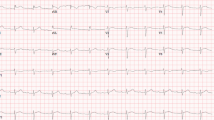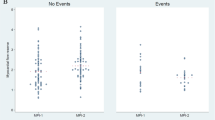Abstract
In an attempt to evaluate the clinical significance of reverse redistribution in Tl201 cardiac SPET, Tl201 SPET examinations included in the data base of our department have been retrospectively reviewed. Patients: Six hundred ninety eight patients demonstrated the pattern of reverse redistribution. For 237 of these patients' cardiac catheterization data were also available. One hundred and six patients of these had a history of myocardial infarction while the rest of them were referred for angina symptoms. Results: Catheterization showed that the infarction area was perfused by a stenosed but patent vessel in 79 of the 106 patients with a history of myocardial infarction (74.5%). Collateral circulation was evident in 21 of these 106 patients (19.8%). Only six patients (5.6%) showed a totally occluded vessel with no obvious evidence of collateral circulation. Of the 131 patients, with no myocardial infarction history, 14 (10.7%) had normal coronary vessels. The rest of the patients (89.3%) demonstrated stenotic vessels perfusing the same area where reverse redistribution was observed. Sixty-three of these patients have been reexamined after 9–36 months. On 15 of these patients (23.8%) the second scintigram showed ischemia in the same segments where reverse redistribution was initially detected. Another 17 of the above patients had a former scintigraphic examination that showed ischemia on the segments that currently demonstrated reverse redistribution. Conclusion: The results of the present retrospective study indicate that, in patients with known coronary disease, the pattern of reverse redistribution frequently indicates the ischemic area.
Similar content being viewed by others
References
Tanasescu D, Berman D, Staniloff H, et al. Apparent worsening of thallium-201 myocardial defects during redistribution — what does it mean?[Abstract].J Nucl Med 1979; 50: 688.
Maddahi J, Berman DS. Reverse redistribution of thallium-201. J Nucl Med 1995; 36: 1019-1021.
Arrighi JA, Soufer R. Reverse redistribution: is it clinically relevant or a washout? J Nucl Cardiol 1998; 5: 195-201.
Weiss AT, Maddahi J, Lew AS, et al. Reverse redistribution of thallium-201: a sign of nontransmural myocardial infarction with patency of the infarct-related coronary artery. J Am Coll Cardiol 1986; 7: 61-67.
Soufer R, Dey HM, Lawson AJ, Wackers FJT, Zaret BL. Relationship between reverse redistribution on planar thallium scintigraphy and regional myocardial viability: a correlative PET study. J Nucl Med 1995; 36: 180-187.
Yamagishi H, Akioka K, Takagi M, et al. Relation between the kinetics of thallium-201 in myocardial scintigraphy and myocardial metabolism in patients with acute myocardial infarction. Heart 1998; 80: 28-34.
Dilsizian V, Bonow RO. Differential uptake and apparent 201T1 washout after thallium reinjection: options regarding early redistribution imaging before reinjection and late redistribution imaging after reinjection. Circulation 1992; 85: 1032-1038.
Marzullo P, Gimelli A, Cuocolo A, et al. Thallium-201 reverse redistribution at reinjection imaging correlated with coronary lesion, wall motion abnormality and tissue viability. J Nucl Med 1996; 37: 735-741.
Silberstein EB, DeVries DF. Reverse redistribution phenomenon in thallium-201 stress test: angiographic correlation and clinical significance. J Nucl Med 1985; 26: 707-710.
Marin-Neto JA, Dilsizian V, Arrighi JA, Bonow RO. Thallium reinjection demonstrates viable myocardium in regions with reverse redistribution. Circulation 1993; 88: 1736-1745.
Wackers FJT, Zaret BL, Chaitman B, Wassermann A, Thompson B. The prognostic significance of reverse redistribution of thallium-201 stress testing after thrombolytic therapy for acute infarction [Abstract]. J Am Coll Cardiol 1992; 19: 22A.
De Sutter J, Van de Wiele C, Dierckx R, Gheeraert P, De Buyzere M, Taeymans Y. Reverse redistribution on thallium-201 single-photon emission tomography after primary angioplasty: a one-year follow-up study. Eur J Nucl Med 1999; 26(6): 633-639.
Pace L, Perrone-Filardi P, Mainenti PP, et al. Effects of myocardial revascularization on regional thallium-201 uptake and systolic function in regions with reverse redistribution on tomographic thallium-201 imaging at rest in patients with chronic coronary artery disease. J Nucl Cardiol 1998; 5(2): 153-160.
Sciagra R, Pupi A, Pellegri M, et al. Prediction of post-revascularization functional recovery of asynergic myocardium using quantitative thallium-201 rest-redistribution tomography: has the reverse redistribution pattern an independent significance? Eur J Nucl Med 1998; 25(6): 594-600.
Dilsizian V, Bonow RO. Current diagnostic techniques of assessing myocardial viability in patients with hibernating and stunned myocardium. Circulation 1993; 87: 1-20.
Kayden D, Sigal S, Soufer R, Mattera J, Zaret BL, Wackers F. Thallium-201 for assessment of myocardial viability: quantitative comparison of 24 h redistribution imaging with imaging after reinjection at rest. J Am Coll Cardiol 1991; 18: 1480-1486.
Pace L, Cuocolo A, Maurea S et al. Reverse redistribution in resting thallium-201 myocardial scintigraphy in patients with coronary artery disease: relation to coronary anatomy and ventricular function. J Nucl Med 1993; 34: 1688.
Wieneke H, Zander C, Eising EG, Haude M, Bockisch A, Erbel R. Non-invasive characterization of cardiac microvascular disease by nuclear medicine using single-photon emission tomography. Herz 1999; 24: 515-521.
Kaul S, Chester DA, Newell JB, Pohost GM, Okada RD, Boucher CA. Regional variability in the myocardial clearance of thallium-201 and its importance in determining the presence or absence of coronary artery disease. J Am Coll Cardiol 1986; 8: 95-100.
Brown KA, Denoit L, Clements JP, Wackers FJT. Fast washout of thallium-201 from area of myocardial infarction: possible artifact of background subtraction. J Nucl Med 1987; 28: 945-949.
Lear JL, Raff U, Jain R. Reverse and pseudo redistribution of thallium-201 in healed myocardial infarction and normal and negative thallium-201 washout in ischemia due to background oversubtraction. Am J Cardiol 1988; 62: 543-550.
van Eck-Smit BLF, van der Wall EE, Kuijper AF, Zwinderman AH, Pauwels EK. Immediate thallium-201 reinjection following stress imaging: a time-saving approach for detection of myocardial viability. J Nucl Med 1993; 34: P737-P743.
Pace L, Cuocolo A, Marzullo P et al. Reverse redistribution in resting thallium-201 myocardial scintigraphy in chronic coronary artery disease: an index of myocardial viability. J Nucl Med 1995; 36: 1968-1973.
Author information
Authors and Affiliations
Rights and permissions
About this article
Cite this article
Koliakos, G., Doumas, A., Altas, D. et al. The clinical significance of reverse redistribution in Tl201 cardiac SPET. Int J Cardiovasc Imaging 17, 29–35 (2001). https://doi.org/10.1023/A:1010692529586
Issue Date:
DOI: https://doi.org/10.1023/A:1010692529586




